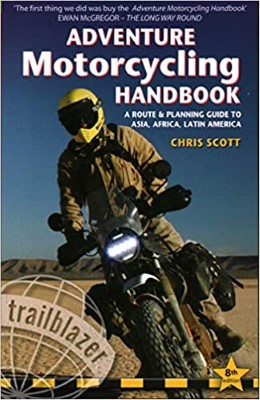 |
|

2 Apr 2013
|
|
Registered Users
New on the HUBB
|
|
Join Date: Jan 2013
Location: Yorkshire
Posts: 19
|
|
|
Roof loading a 4x4. Fact or fiction
The general rule of thumb is dont put anything on your roof unless you have to, right!?
When over landing this is pretty difficult especially when in a less than spacious car (discovery 2 v8)
Landrover say don't put more than around 100 kg on the roof including the roof rack! That doesn't leave much weight allocation for my essential manicure set.
I have been as anal as possible about weight distribution and extra load, and ok I probably don't really need rock sliders but I got em on ebay and just couldnt resist!
From what i can gather over landers regularly 'overload their roof' as far as what lr say you can put up there. So what can you actually get away with, many people put numerous 20kg jerry cans on the roof.
Surely the weight distribution throughout the car is as important as total roof load, as a 3t car could handle 200kgs on the roof way better than an empty car.
On my roof I have a full length safety devices roof rack which i cut down to take the top rail off, roof tent, 2 jerry cans (empty most of the time) large aluminium box for loading light weight items. I estimate this load to be 150kgs.
BUT the car has lots of low down weight, full underbody protection, long range 125l steel fuel tank, 80l water tank behind front seats, and I load all spare parts and heavy items as lox central and near rear axle as possible. Fully loaded we are not far off the GVW of around 2800kg.
The car also has HD OME springs and shocks plus air bag helpers at the rear should we need them, new brakes, and ACE anti roll system. Plus new AT tyres, wheel spacers for a little extra stability.
I am struggling to reduce the roof load but it handles fine on and off road , with full jerry cans you can feel it but when possible I put full ones in the car.
What do you think about roof loading? Any comments welcome
Last edited by TheAfricaSchoolRun; 2 Apr 2013 at 11:57.
Reason: Forgot to ask for comments
|

2 Apr 2013
|
|
Registered Users
Veteran HUBBer
|
|
Join Date: Oct 2007
Location: Bridgend, South wales
Posts: 108
|
|
|
Hi 1st off let me preface my comments by saying I now drive a soft top,
however over the years I've seen numerous problems with badly or overloaded and broken roofracks, the results are normally ripped off drip rails and cracked windscreens.
I've always tried to avoid using them, the only helpfull thing I've found for them is storage for firewood i've picked up along the route and as an observation platform.
I've seen numerous people struggle to get spare tyres down from a roof rack and then been unable to get the muddy flat back up on top, as for storing fuel up there - empty cans only.!
A few years ago a car in front of me at the Barra river crossing in Senegal had the luggage straps cut and their "kit" dragged off the roof and stolen just as they were about to board the ferry.
The roof ratings are there for a reason eg..manufacturers legal liabillity, the very best you can expect if you exceed the recomendations and have an accident is your insurance company happily walking away from all liabillity.
At worst it will leave you greasy side up on the side of a remote track, injured and needing local hospital treatment.
It will not matter how much low down weight you have under the truck when it starts to pendulum on a sandy piste at speed.
A personal view is roof racks are great for temporary storage or RTT platform, if you dont have space for it inside are you taking too much?.
regards
Gren
|

2 Apr 2013
|
|
Contributing Member
HUBB regular
|
|
Join Date: Feb 2012
Location: Humberston
Posts: 51
|
|
|
I'm sure alot of people have various ideas on roof racks. I have a Toyota 4Runner and made a full length roof rack made up of Thule roof bars. Three of these fasten within the door openings and I had the rear one floating. The rack wieghed about 30 kgs and the roof tent was 50 kg. Had 2x20ltr water and 2x20ltr fuel carriers at the rear.If ever we had fuel in the jerry cans they were put in the main tank as soon as possible.Had no problems at all on a 9k trip to southern Morroco and intend to use the same system for a trip next year to Mongolia. Will exchange a couple of alloy boxes instead of a roof tent as we will sleep inside the truck. Think probably the Thule bars could be stronger than gripping the rain gutter. Hub member Bundbasher regularly carries 3-400 kgs on his Toyota roof.
|

2 Apr 2013
|
 |
-
Veteran HUBBer
|
|
Join Date: Apr 2006
Location: WWW
Posts: 2,341
|
|
'Unwritten rules'
The lighter the better ALWAYS holds true.
Less stress on all components means less chance of a breakage and less wear and tear.
The higher the weight the greater the chances of a topple/roll over.
I have a Hilux and keep heavy stuff (fuel jerries etc.) over the rear axle.
I avoid putting anything on the roof if I can.
I fing an excel loading spreadsheet helps 
IMHO keeping kit to a sensible minimum and keeping things light has always worked for me.
|

2 Apr 2013
|
|
Registered Users
Veteran HUBBer
|
|
Join Date: Feb 2004
Location: UK
Posts: 1,232
|
|
I always put jerries on the roof, inside they always smell!!
I'm reluctant to carry fuel in the vehicle, I just don't think it's safe, even diesel, but especially petrol that you'll be carrying.
when you fill from jerries leave them to stand for a while before opening to avoid a petrol fountain and make sure you earth your vehicle. refilling petrol in the desert from cans is incredibly dangerous. The fuel has been shaken up and is hot.
The main thing is to try and spread the load as much as possible with multiple contact points to the roof.
mt landcruiser rebuild willinclude fitting a long range tanks to reduce the need to carry jerries. I'll just have one for emergencies.
secure them to the rack with a metal cord and good quality padlock.
Loadspace in a disco isn't massive but if there are only two of you it should be enough to leave you only needing to put jerries and tent on the rack. If it isn't then as above your carrying too much, and you need to consider your all up weight. Weight is the killer of components.
As above, use your cans as soon as possible to keep the weight on the roof to a minimum. Using a V8 you shouldn't need them full for long 
|

3 Apr 2013
|
|
Registered Users
Veteran HUBBer
|
|
Join Date: May 2006
Location: Bribie Island Australia
Posts: 678
|
|
|
Over the years I've seen the results of roofracks destroying vehicles - not just 4x4s. The results are usually roof gutters swinging in the wind with a large hole in the roof opening and closing as they drove down the road. Doors that dont close without being shouldered closed. Cracked windscreens. Creases in the roof. A lot of abandoned kit on the side of some dirt road after 300kms or 400kms of corrugations - sometimes the complete vehicle gets dumped.
Succesful roof racks are fitted to vehicles with gutters so that a continuous piece of steel can sit in the gutter and distribute the weight as well as securing the rack in 4 to 6 places.
Dont fit ladders to the roofrack that are bolted to the chassis, the ladder or roofrack will fail. The body is isolated from the chassis and will flex at a different rate.
Dont build roofracks that are bolted to the chassis like a roll cage, the chassis or rack will fail.
If a manufacturer has bothered to give a roofrack load limit it is because they have either tested in pre production or have field experience that dictates that (conservative) limit. If they sell a roofrack as an accessory item it will have been tested on the vehicle.
Above about 75kph a roof rack will destroy your fuel consumption. Put a cover on your roofrack to improve fuel consumption a little bit.
There are now plastic jerry cans which are lower and wider which do the job just fine and keep the weight down lower than the old style steel ones.
Personally I liked the old Series LRs solution to carrying a spare wheel and that was to bolt it onto the bonnet - but nowadays that solution would fail when the vehicle gets barrier tested. But there are often Series spare wheel carriers on eBay for the brave.
|

3 Apr 2013
|
|
Registered Users
Veteran HUBBer
|
|
Join Date: Feb 2004
Location: UK
Posts: 1,232
|
|
|
bonnet mounted spares cause the bonnet mounts to fail. don't fit one to a 300tdi landy as it will crack the injectors (thats why wolfs have side mounted spares despite having the gear on the bonnet to fit them. They found out after the design stage). Doesn't really apply to you though as your in a disco.
DO NOT use plastic fuel cans from halfords in the desert. They will balloon up causing the straps to become loose and/or the cans will split. They also don't have the capacity for what you will need. only good quality metal cans are good enough unless possibly it is a properly designed composite type but I have no experience or knowledge of those.
|

3 Apr 2013
|
|
Registered Users
Veteran HUBBer
|
|
Join Date: Aug 2008
Location: Dorset, UK
Posts: 339
|
|
Funny you say Halfords Moggy 
I've been using a pair of Diesel Halfords 10L plastic cans for five years without any problems, they weigh next to nothing empty, don't rattle, don't smell and don't leak. Far easier to store compared to Jerry Cans as well.
Link if it works
|

3 Apr 2013
|
|
Registered Users
Veteran HUBBer
|
|
Join Date: Feb 2004
Location: UK
Posts: 1,232
|
|
|
yeh, I've got one of those actually!! Only bought it 'cos they won't let me fill my 20L jerries in the UK! I wouldn't use it on an expedition in preference to my jerries though.
do you carry petrol or diesel in it?
|

4 Apr 2013
|
|
Registered Users
Veteran HUBBer
|
|
Join Date: Aug 2008
Location: Dorset, UK
Posts: 339
|
|
Only Diesel Moggy.
With all seriousness they have travelled many miles of corrugated pistes without a problem 
|

4 Apr 2013
|
|
Registered Users
Veteran HUBBer
|
|
Join Date: Oct 2004
Location: London
Posts: 542
|
|
|
I think there are fundamentally two issues with loading up your roof rack.
Firstly, will the extra weight cause extra strain on the rack causing it or something else to fail?
Secondly, will it alter the dynamics of the vehicle at speed or off road?
In most overland situations I doubt the second is really an issue unless you are driving at excessive speeds on pistes, cornering at high speed or doing lots of dune driving. Therefore it really comes down to whether the rack can handle the extra weight. That largely depends on the build quality of the rack.
I know people like to carry extra fuel on the roof, but I don't really see the point of this as there are much better options. In my mind this is either a long range fuel tank or else using fuel bladders. I have to confess that I have never used a soft fuel bladder in a 4x4 but have used them extensively on bikes, where they are a good option. I do wonder why more people don't consider these as an option?
|

5 Apr 2013
|
|
Registered Users
Veteran HUBBer
|
|
Join Date: Feb 2004
Location: UK
Posts: 1,232
|
|
Quote:
Originally Posted by twenty4seven

Only Diesel Moggy.
With all seriousness they have travelled many miles of corrugated pistes without a problem  |
I'll take mine with me next time then! 
the poster will be carrying petrol though, which is more where my concern would lie as it is much more volatile and gasses off more giving more pressure in the container. Diesel is pretty inert. I would still stand by my comments for carrying petrol in containers.
If you take used jerries though test the seals and buy some spare new ones.
|

5 Apr 2013
|
|
Registered Users
Veteran HUBBer
|
|
Join Date: Feb 2004
Location: UK
Posts: 1,232
|
|
Quote:
Originally Posted by Matt Roach

In most overland situations I doubt the second is really an issue unless you are driving at excessive speeds on pistes, cornering at high speed or doing lots of dune driving. Therefore it really comes down to whether the rack can handle the extra weight. That largely depends on the build quality of the rack.
|
on corrugations speeds can easilly reach 50mph as you try to float the bumps, and at that speed, especially in a relatively short vehicle like a disco, things can go wrong pretty quickly. I have also seen vehicles roll at very low speeds on relatively flat terrain. There are plenty of examples of vehicles rolling with heavy roofracks so stability is very definately an issue.
|

6 Apr 2013
|
|
Registered Users
Veteran HUBBer
|
|
Join Date: May 2008
Location: Mid Wales
Posts: 100
|
|
|
I've had plastic jerry cans rub through rediculously quickly on sand tracks on a roof rack.
The roof rack on my old 109 was really useful for transporting a Unimog tipping bed, stupid numbers of canoes, broken trailers and all sorts. Driving appropriately is critical.
|

13 Apr 2013
|
 |
Registered Users
Veteran HUBBer
|
|
Join Date: Sep 2001
Location: Portugal
Posts: 1,134
|
|
|
There is 'weight' and then 'weight that sloshes about' ;-) Weight that moves about like liquid is more of a problem, try to keep any jerries very full to avoid sloshing about.
African travellers I meet with jerries on top hardly ever used them for a variety of reasons. Made the vehicle unstable when full, messy to fill and load/unload, tiring to unload when full or messy pumps etc etc. They looked good before leaving, made the vehicle look all expedition ;-p
If you definitely need extra range at times, or can save $100 by filling up somewhere really cheap a few times and weren't going to use the roofrack space anyway, then maybe not a bad idea.
The more weight you have up top the slower you have to drive, the worse your cornering is and the less you can swerve and brake. The easier you will tip over when you hit the pot hole you didn't quite see in time, or on the even bush track etc.
Basically you are reducing the capacities of your vehicle the more you load, especially on top. Understand this and account for it accordingly after making the judgement of if its worth it.
To me 100kg for a solid roofrack, rooftent, awning, solar panel and storage space for really light items in Africa is worth the trade off. Rooftent fantastic.
I drive very slowly and carefully, except towards the end of the day! ;-p
(all from my own perspective of doing hard and long African trips)
|
|
Currently Active Users Viewing This Thread: 1 (0 Registered Users and/or Members and 1 guests)
|
|
|
 Posting Rules
Posting Rules
|
You may not post new threads
You may not post replies
You may not post attachments
You may not edit your posts
HTML code is Off
|
|
|
|

Check the RAW segments; Grant, your HU host is on every month!
Episodes below to listen to while you, err, pretend to do something or other...

2020 Edition of Chris Scott's Adventure Motorcycling Handbook.
"Ultimate global guide for red-blooded bikers planning overseas exploration. Covers choice & preparation of best bike, shipping overseas, baggage design, riding techniques, travel health, visas, documentation, safety and useful addresses." Recommended. (Grant)

Ripcord Rescue Travel Insurance™ combines into a single integrated program the best evacuation and rescue with the premier travel insurance coverages designed for adventurers.
Led by special operations veterans, Stanford Medicine affiliated physicians, paramedics and other travel experts, Ripcord is perfect for adventure seekers, climbers, skiers, sports enthusiasts, hunters, international travelers, humanitarian efforts, expeditions and more.
Ripcord travel protection is now available for ALL nationalities, and travel is covered on motorcycles of all sizes!
What others say about HU...
"This site is the BIBLE for international bike travelers." Greg, Australia
"Thank you! The web site, The travels, The insight, The inspiration, Everything, just thanks." Colin, UK
"My friend and I are planning a trip from Singapore to England... We found (the HU) site invaluable as an aid to planning and have based a lot of our purchases (bikes, riding gear, etc.) on what we have learned from this site." Phil, Australia
"I for one always had an adventurous spirit, but you and Susan lit the fire for my trip and I'll be forever grateful for what you two do to inspire others to just do it." Brent, USA
"Your website is a mecca of valuable information and the (video) series is informative, entertaining, and inspiring!" Jennifer, Canada
"Your worldwide organisation and events are the Go To places to for all serious touring and aspiring touring bikers." Trevor, South Africa
"This is the answer to all my questions." Haydn, Australia
"Keep going the excellent work you are doing for Horizons Unlimited - I love it!" Thomas, Germany
Lots more comments here!

Diaries of a compulsive traveller
by Graham Field
Book, eBook, Audiobook
"A compelling, honest, inspiring and entertaining writing style with a built-in feel-good factor" Get them NOW from the authors' website and Amazon.com, Amazon.ca, Amazon.co.uk.
Back Road Map Books and Backroad GPS Maps for all of Canada - a must have!
New to Horizons Unlimited?
New to motorcycle travelling? New to the HU site? Confused? Too many options? It's really very simple - just 4 easy steps!
Horizons Unlimited was founded in 1997 by Grant and Susan Johnson following their journey around the world on a BMW R80G/S.
 Read more about Grant & Susan's story
Read more about Grant & Susan's story
Membership - help keep us going!
Horizons Unlimited is not a big multi-national company, just two people who love motorcycle travel and have grown what started as a hobby in 1997 into a full time job (usually 8-10 hours per day and 7 days a week) and a labour of love. To keep it going and a roof over our heads, we run events all over the world with the help of volunteers; we sell inspirational and informative DVDs; we have a few selected advertisers; and we make a small amount from memberships.
You don't have to be a Member to come to an HU meeting, access the website, or ask questions on the HUBB. What you get for your membership contribution is our sincere gratitude, good karma and knowing that you're helping to keep the motorcycle travel dream alive. Contributing Members and Gold Members do get additional features on the HUBB. Here's a list of all the Member benefits on the HUBB.
|
|
|